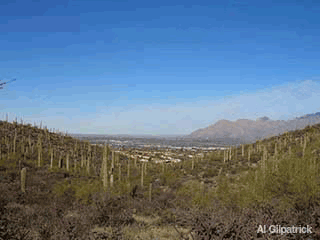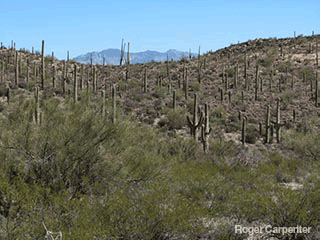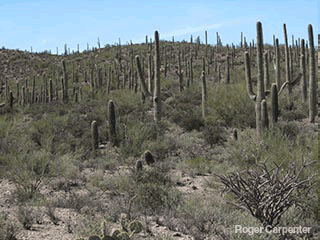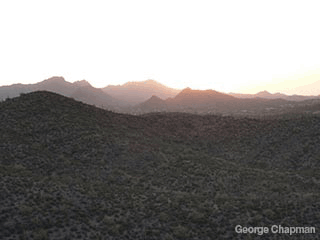|
The following is from tucson.com, the Arizona Daily Star: July 02, 2014 12:00 am • By Jamar Younger
PAINTED HILLS PURCHASE The county will move forward with the purchase of a coveted 286-acre parcel in the west-side Painted Hills area. The board voted 4-1 to use $3 million from a 2004 open-space program to make a down payment on the land, which is owned by the Dallas Police and Fire Pension System. Miller voted against the measure. The county will buy the land for $7.5 million, including the down payment. The county had to wait for the Tucson City Council to vote on a bond ordinance amendment because the money was originally designated for a city open-space project. The council unanimously approved the amendment Monday night. County officials hope to pay the balance of the cost with money set aside for open space from a November 2015 bond election. If that option fails, the money could come from a special environmental fund the county shares with the JW Marriott Starr Pass Resort, funded with sales revenue from the resort. The fund could generate between $800,000 and $1 million a year beginning in 2016. The county would then pay five annual payments of about $1 million. The purchase of the saguaro-studded Painted Hills property is part of the county’s effort to preserve open space and connect the area to nearby Tucson Mountain Park. The Painted Hills — A happy conclusion to a four year struggle? by Roger Carpenter “EARLY” HISTORY It is likely that everyone living in the Tucson Mountains knows of the Painted Hills. These 287 acres of rocky hills and dense stands of saguaros lie between West Speedway Boulevard and West Anklam Road, with their eastern boundary on the Tucson City limits. Both Speedway and Anklam have been designated scenic routes by Pima County. The landscape is so striking that one often sees visitors stopped to have their pictures taken on what must be their first view of the Upper Sonoran Desert. It is home to nearly all of the native species found in the Tucson Mountains. Because of its beauty, this property was twice put on the list of parcels for purchase in the open space bond elections of 1997 and 2004. As always happens, the list of properties exceeded the funds available for their purchase; moreover, in this case Pima County was unable to find the necessary willing seller, a trustee of the trust owning the property at that time. However, the parcels were bought by two developers in 2004 and 2005. The developer holding the option to purchase the western 40% submitted plans for an 80-house “Conservation Subdivision,” called “Desert Rose Canyon.” He later exercised his option, but immediately sold the property to Jonathan Tate, owner of the eastern portion, who had submitted plans for a standard CR-1 subdivision of 67 lots, “Indigo Ridge.” The entire property had to be zoned CR-1 (1 house per 36,000 square feet) by Pima County on its very first zoning map in 1953. Tate paid a total of $4.43 million for all of the land. Pima County attempted to contact Tate to discuss purchasing the Painted Hills using the County Open Space Bond. The county is constrained to purchasing property for appraised value, however, and Tate indicted through a third party that he would want his purchase price plus his costs spent to plat the property and the profit he would garner from his planned 147 house subdivision, an amount in excess of $25 million (more than five times the expected appraised price). In less than a year, Tate did sell the Painted Hills to the Dallas Police and Fire Pension Fund for $27 million. This was about $95,000 per acre of land that would be extremely difficult to build on. Comparatively, the average price per acre for land purchased with these bond funds in the Tucson Mountains was less than $10,000 per acre. Since the prominent ridges were already formally protected under the County’s Protected Peaks and Ridges ordinance, the cost per buildable acre was far higher. In order to realize a profit on their land speculation, the developers of the project, Land Baron Corp. of Las Vegas, Nevada, initially proposed “The Peaks at Starr Pass — building 317 houses on the portions of the property where slopes were less severe. This resulted in a plan, under the “Cluster Option,” in which most of the houses were to be built at high densities, on 60’ by 120’ lots, with 5’ side yards, crammed along Speedway and Anklam — an effect not much different in appearance from townhouses. Neighborhood opposition was vigorous. At all subsequent stages of the process, complaints were made about the effects of this development on view sheds, impacts on about half of the 9,000 to 10,000 saguaros, the importance of the Painted Hills as a buffer to nearby Tucson Mountain Park, and wildlife corridors. After several meetings with residents, and later with our representatives, the developers changed the name to “Painted Hills” and agreed to reduce the number of houses to 284 units, saying that they could not make a profit if the number of houses was less. The Cluster Option required that the plan be approved by the Design Review Committee (DRC). At its hearing on January 18, 2007, the developers were directed to return with modification, including some reductions in the number of housing units. They returned in July with a request for 260 houses. County staff recommended that the project be limited to 205 houses, an arbitrary number based on the average of 145 houses proposed for two earlier developments, and the 260 asked for by Land Baron. The Pima County Environmental Planning staff then recommended a reduction of 50 sites fewer than the 260, and specified the individual lots that should be omitted to improve conditions for wildlife. The developers again pleaded that they could not make the project financially successful if the number of houses was less. On a split vote, the DRC approved the developers request for 260 units, largely located along Speedway and Anklam. At that time, County Code allowed developers the right to appeal a decision of the DRC, but gave no such right to other affected parties. The residents’ complaint about this to the Board of Supervisors eventually resulted in a code change to permit any interested party to appeal a decision of the DRC, but, of course, this could not be made retroactive. And several residents filed a lawsuit against the previous decision and process, but this did not result in any change in plans. RECENT HISTORY For several years nothing appeared to happen with the project. When checking with the County’s Subdivision Coordination office, we were told that the final plat had not been approved because they did not have an assurance of water. Indeed, on April 14, 2008, Tucson Water notified the developers that “Tucson Water is unable to reissue a water assurance letter, which expired on February 8, 2008, due the original applicant’s failure to submit a master plan to Tucson Water for review by that date.” On October 8, 2008, the developers filed a Notice of Claim against the City of Tucson for damages in the amount of $45 million, over its denial of water service under the interim water policy. In the winter of 2009/10 they also asked that the Painted Hills property be annexed into the City, with the objective of being eligible again for water service. On April 5, 2010. representatives of a number of environmental groups met with officials of Tucson Water to review the long range water service plans. Several areas along Speedway and Anklam corridors, adjacent to Painted Hills, were indicated as being eligible for water service if they were annexed into the city. The potential delivery of water to the Painted Hills, via annexation, was the key to the plans. Throughout this spring a number of west side representatives, organized and led by TMA’s Ed Verburg, explored all methods for blocking annexation, or extracting concessions from the developers. Members of this “Team,” made up of representatives from TMA, the Coalition for Sonoran Desert Protection, and Gates Pass Area Neighborhood Association, met individually with each of the City Council members and with Mayor Walkup’s assistant, hoping to discourage a vote for annexation. The reluctance of some councilors was clear: at risk was a lawsuit the city might lose. Initially, the City Council twice voted to move forward with annexation. In contrast, the Pima County Board of Supervisors voted 4 to 0 to request the city not to annex the Painted Hills property. The City Council reconsidered their action at a June 8, 2010 meeting during which a large segment of the community voiced their concern about the annexation. The Council agreed to pursue a purchase/land swap proposal for the land, and asked for the county’s assistance. After the Council’s decision, there were a number of meetings to help make this option workable at the office of Councilor Regina Romero. Participants included County Supervisor Richard Elías, City Manager Mike Letcher, county and city land and bond experts, leaders of the conservation efforts such as Carolyn Campbell, and Chris Avery, Attorney for Tucson Water. News of the development appeared again in the local newspaper, and even in the Dallas media, home of the Pension Fund. It now appears that the developers and property owners are willing to consider alternatives. It seems possible, perhaps even likely, that through a mix of city open space bond monies, plus exchanges of some other properties suitable for development, the Painted Hills may at last enter into public ownership. Although judicial hearings are still pending, the fact that such negotiations are underway relieves pressure from the threat of the lawsuit for all parties. Additionally, the water footprint recently discussed by the City Council deletes the provision of water to the parcels on either side of Painted Hills. |




